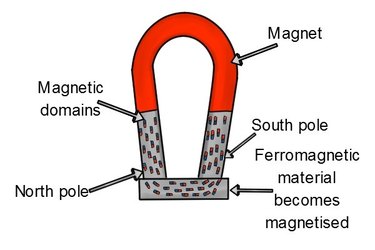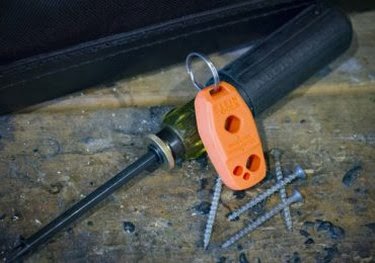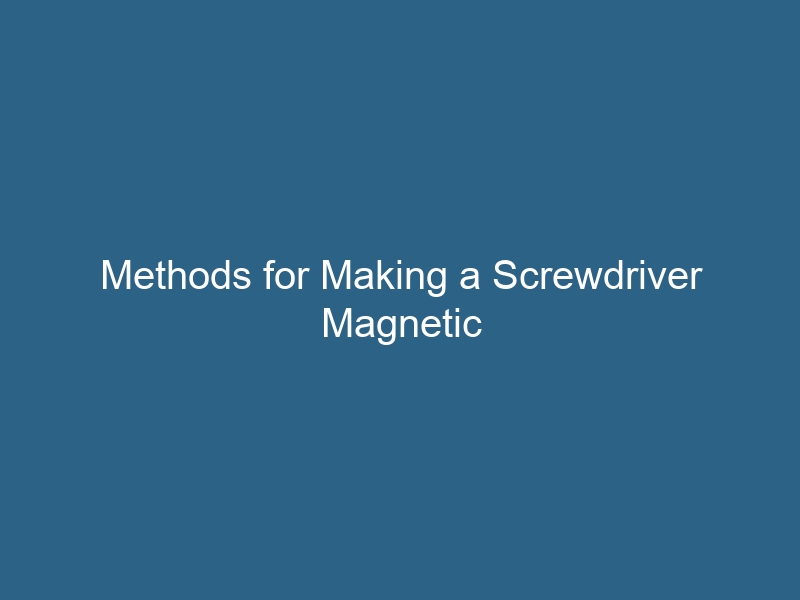Quck answer
To magnetize a screwdriver, follow these simple steps:
1. Find a strong magnet, such as a neodymium magnet or a magnetic strip.
2. Stroke the magnet along the length of the screwdriver multiple times, in the same direction.
3. Repeat the process on both sides of the screwdriver to ensure maximum magnetization.
4. Test the magnetized screwdriver by attracting small metal objects, such as paperclips or screws.
5. If the screwdriver loses its magnetism over time, repeat the magnetization process.
Remember to exercise caution when working with magnets, as they can cause damage to electronic devices and credit cards.
When it comes to driving screws, it often feels like you need an extra hand. One hand is needed to hold the screw, another to turn the screwdriver or operate the drill, and a third to keep the objects aligned. Unfortunately, nobody has three hands. However, if your screwdriver could hold the screw for you, you could easily complete most tasks using just your two hands. This is why professional tradespeople use magnetized screwdrivers and driver bits.
A magnetized screwdriver serves multiple purposes. It eliminates the need to hold the screw when working in tight spaces where your other hand can’t fit. It can also prevent screws from falling and getting lost when removing them from tight spots. Additionally, if a screw or other small metal object does happen to fall, you can use the magnetized screwdriver to retrieve it.
Only Ferromagnetic Materials Can Be Magnetized

Atoms align themselves with the field of a permanent magnet.
Image Credit:
Wonkee Donkee Tools
You can buy a pre-magnetized screwdriver or screwdriver bits, but there’s no need to spend money when it’s easy enough to magnetize a screwdriver yourself. However, there is one requirement: the shaft of the screwdriver must be made of a ferromagnetic material, which means it must contain iron, nickel, cobalt, or a rare earth element like gadolinium or ruthenium.
Luckily, most screwdrivers and screw bits are made of a steel alloy that contains iron, the most well-known ferromagnetic material. Specialized screwdrivers made from non-ferromagnetic materials, such as super-hard titanium or titanium alloys, cannot be magnetized.
How to Magnetize a Screwdriver or Screwdriver Bit
Magnetizing the steel shaft of any screwdriver is simple. Just bring it into contact with a permanent magnet, and the steel will become magnetized for approximately three months. Any magnet will work, but stronger ones are more effective than weaker ones. It is recommended to use a magnet with a pull force of at least 1/4 to 1 pound. Neodymium magnets, which are available at hardware stores, work exceptionally well. These stores also often sell screwdriver magnetizers specifically designed for this purpose.

A screwdriver magnetizer, which is essentially a magnet enclosed in plastic, can be purchased.
Image Credit:
Pro Tool Reviews
- To remove rust and dirt, clean the screwdriver or screw bit with a cloth. If the shaft is particularly oily, you may want to use paint thinner or a lubricant like WD-40.
- Hold the screwdriver or screw bit in one hand and touch the magnet to the shaft. If it sticks, the shaft is made of a ferric material and is suitable for magnetizing. If there is no attraction, the tool cannot be magnetized permanently.
- Move the magnet along the shaft from the base to the tip. Rotate the shaft 1/4 turn and repeat the motion in the same direction, going from the base to the tip. Continue until you have completed a full rotation of the shaft.
- Test the magnetic strength by using the screwdriver to pick up a screw. If the attraction is not strong enough, repeat steps 2 and 3.
- If necessary, demagnetize the screwdriver by running the magnet along the shaft in the opposite direction.
Tip
If the magnet does not stick to the screwdriver shaft, it is made of a non-ferromagnetic material like titanium. However, many of these materials are paramagnetic, meaning they can act as magnets when in contact with a permanent magnet. If you want to make a titanium screw bit for your drill magnetic, use it together with a magnetic bit holder.
Alternatives to Neodymium Magnets and Commercial Magnetizers
If you prefer not to buy a magnetic screwdriver or screw bit from a store, it is unlikely you would want to purchase a neodymium magnet or commercial magnetizer either. No problem. You probably have magnets at home that will work just as well. Here are some places to look:

Any of the decorative items stuck to your refrigerator can magnetize your screwdriver.
Image Credit:
amazon.com
- Objects stuck to your refrigerator doors often have magnets strong enough for the job. The harder it is to remove the object from the refrigerator, the better it will work.
- Audio speakers are built with powerful permanent magnets. If you can reach the back of a speaker, rub the screwdriver shaft along the flat part where the speaker wires are connected. For safety, remember to disconnect the wires first.
- Kitchen and bathroom cabinets often have magnetic latches. Rub the screwdriver along one of these magnets to magnetize it.
- Your battery drill may have a magnetic screw holder on the base. This magnet should be strong enough to magnetize your screwdriver or screw bit.
Tip
Using a steel-alloy drill bit with a magnetic bit holder magnetizes the bit, and it will remain magnetized even when used without the holder. The magnetic field wears off after a few months, or sooner if the screwdriver is dropped or hit with a hammer. When the screwdriver becomes demagnetized, use it with the holder or rub it with a magnet to re-energize it.
Alternative Methods for Magnetizing a Screwdriver

Generating a magnetic field can be achieved through various means.
Image Credit:
Kaidi Electromagnetic
Utilizing electricity: One way to magnetize a screwdriver involves wrapping the shaft with insulated conducting wire and connecting it to a power source. However, this technique only works with alternating current since the change in current strength and direction, known as flux, generates the magnetic field. It is important to note that attempting this method is not recommended. If you were to proceed, you would require a step-down transformer to convert the voltage from your power outlet to a safe level of a few volts. It is extremely dangerous to directly insert wires into a power outlet. Never attempt this.
A much safer approach involves using a 9V battery, which serves as a direct current power source. As the current flows in a single direction and maintains a constant intensity, there is no flux to create a magnetic field. However, it is possible to construct a charging solenoid by wrapping wire around a short section of 1/2-inch copper water pipe, allowing the screwdriver shaft to freely pass through it. Connect the wire to a 9V battery and move the screwdriver back and forth inside the pipe to generate flux. For optimal results, use 16 to 22 AWG insulated wire and wrap it around the pipe at least 20 times.
Using a hammer: By repeatedly striking the screwdriver shaft with a hammer, it is possible to jolt the iron atoms in the steel enough to align them in the same direction and produce a magnetic field. Although this method may require time, it is useful to know in case you urgently need a magnetic screwdriver and have no access to magnets. Similarly, once the screwdriver becomes magnetized, hitting it with a hammer can disrupt the alignment of the iron atoms and eliminate the magnetization.


